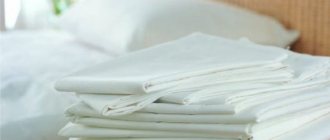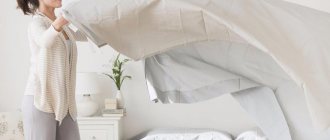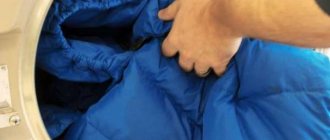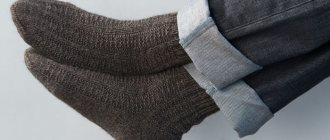How to process different fabrics?
Most often, cotton or linen fabrics are treated with a starch solution. To process them, use the methods described above. To process other materials you need to know some nuances.
Chiffon
Thin chiffon requires delicate handling. This fabric is often starched before cutting, since the thin fabric does not hold its shape well and it is not easy to cut out parts from it. A soft solution is used for processing.
Fatin
Tulle is often used to make fluffy petticoats. To keep the petticoat in shape, use a solution of medium concentration. If you need to starch a veil for the bride, then a weak concentration is used.
Immerse the item in the solution for 2-3 seconds, no more. Then the item is carefully wrung out, straightened and dried.
Lace
Starch lace using a solution of medium and hard concentration. The first option is suitable if the lace trim of clothes is processed. Lace napkins are treated with a harsh solution.
To give the lace a dazzling white hue, use rice starch, diluting it in milk.
How to iron and dry starched items
Dry the fabric until it becomes slightly damp, then begin ironing
All fabrics are ironed while still wet, on both sides, but in slightly different ways:
- silk - through smooth fabric;
- tulle - ironed while wet, straightening the folds;
- embroidered products - only on the reverse side;
- lace - through smooth fabric or gauze;
- gauze - iron damp, straighten folds immediately;
- A white school apron is ironed with a warm iron.
If you first add a little salt to the starch solution, the fabrics will not stick to the iron and will acquire a unique shine.
They should also be dried differently:
- a silk blouse and dress are carefully hung on hangers;
- tulle, gauze are dried in a straightened form;
- a lace school apron is dried by laying it out on a horizontal surface;
- embroidery canvas is also dried horizontally;
- Thin embroidered napkins or lace are dried on a towel, pinned with invisible edges, and straightened.
Any starched items should not be dried in the cold or in direct sunlight.
Spray for applying starch before ironing
The better to starch
To prepare the paste, use a product made from potatoes or corn. There are no fundamental differences between these types of starch. But more often it is potato powder that is used. It is convenient to brew it with boiling water, since the paste quickly becomes thick. The result is a snow-white or bluish-tinged solution. The disadvantage that some housewives note is related to compliance with the rules of starching. If you move away from them, the fabric takes on a yellowish tone.
Corn-based starch does not turn fabric yellow. It also gives quality shape to the fabric. The only inconvenience is preparing the solution. For good consistency, the paste needs to be boiled for about 5 minutes.
You can prepare a paste from rice or wheat. But such a product is very rarely used for starching linen. In addition, such products are much more expensive than the usual potato powder.
Additional uses of starch
Don't think that starch is only suitable for washing; it can be used in many situations around the house.
If you apply liquid starch to the windows, let it dry and simply sweep away the remaining powder with a clean rag, then you can forget about buying special window cleaning products.
Starch absorbs liquid well, which can help with coffee stains on any surface.
The powder can remove unpleasant odors from shoes.
Basic processing methods
Starching things is done in two ways. Most often, manual processing is performed to give elasticity to the tissues. Individual items and bed linen can be starched in an automatic washing machine. But the latter technique is not used for products that require partial starching.
Manually
This method can be used to starch any linen at home. The classic method involves soaking things in a basin or other container with a diluted solution. Thus, bulk products or bedding sets are processed.
Small items that need to be given a rigid shape, or individual items of clothing, for example, collars, cuffs, flounces, are starched by applying the solution with a brush. Before this, the product is washed and, when wet, laid out on a fabric backing. The paste is picked up with a wide brush and evenly applied to the workpiece.
Products are treated with a soft solution during ironing by spraying. A small concentration of diluted paste is poured into a spray bottle and sprayed onto clothing. Immediately apply an iron to the treated area. This technique is suitable for processing delicate and thin fabrics.
Important! After starching, clothes are ironed only when damp, using an ironing iron. It will protect the soleplate of the iron from scorching and soot.
How can starch harm you?
Some experienced housewives do not recommend starching laundry either in a washing machine or by hand. Their fears are truly justified. When bed linen is starched, air does not pass through the fabric well because the spaces between the fibers become clogged with the substance.
As a result, the fabric does not absorb moisture well and does not allow the body to breathe. This contributes to feelings of discomfort during sleep. In addition, there is a high probability of mold or mildew formation. Therefore, it is highly undesirable to starch bedding.
How to make your own mixture
It is well known that fabric differs in structure, thickness and other properties. Based on this, clothes need to be starched in different ways, taking into account the characteristics of the selected textile.
Processing options: table
| View | What is it suitable for? | Recipe |
| Soft | Bed linen, curtains and thin fabrics (cambric, tulle, chiffon). | Dilute 1 tsp in 1 liter of water. starch. Stir until the lumps disappear. |
| Average | Shirts, tablecloths, lace items, bows, napkins, robes. | The amount of substance for the same volume of liquid is greater - 1 tbsp. |
| Hard | Collars, cuffs and other parts that need a stable shape. It is not recommended to completely cover the item with such a thick film. | For 1 liter of water you will need 2 tbsp. starch. Dissolve until smooth. Dilute 1 tsp in a small amount of hot liquid. and add to the solution. Mix thoroughly until a homogeneous consistency is obtained. Let it brew for 2 hours. |
Tip: you can use not only potato starch, but also corn, rice or wheat starch. The product obtained from tubers is especially popular because it thickens well.
Useful tips
Not all housewives understand why they starch their laundry and prefer to use store-bought products. The use of starch allows you not only to refresh your laundry, but also to give it shine and restore its whiteness:
- To make the item shine, you can treat it with a mixture of talc (1 tsp), borax (2.5 tsp) and starch (2 tsp). Mix all the ingredients, moisten a gauze cloth in the solution and iron the product through it. The effect of the procedure will last for a long time.
- To avoid difficulties with ironing, you can add 2 tsp to the paste. cow's milk or a small amount of turpentine.
- Table salt and ordinary bluing give things whiteness. They are also added to the finished mixture.
- Drying clothes in the cold is not recommended. Cold air will reduce the effect of starching, so you need to hang the products in a warm room.
This method also has disadvantages - it cannot be used on items made of dark fabric or items made with synthetic fibers. You cannot starch underwear, regardless of what material it is made of, since the substances used block the free circulation of air. Because of this property, starch does not allow the body to breathe and does not absorb moisture well, and this negatively affects human hygiene.
(
1 ratings, average: 5.00 out of 5)
Starching things by hand
To treat laundry with starch at home, you need to brew the starch in the same way as for use in a washing machine. If we are talking about large duvet covers and sheets, then more liquid will be required. For this purpose in 20 l. water diluted with 3 tbsp. starch and completely immerse the item in the resulting composition.
After a short amount of time, you need to take out the laundry, lightly wring it out and shake it out so that there are as few folds and creases as possible. Leave the item to dry, straightening it well on a clothesline or clothes dryer. After a few hours, you can fix the result by ironing the product with an iron at medium temperature.
Traditionally, potato starch is used for this procedure, but other types can be used at home:
- corn;
- rice;
- wheat;
- barley.
Their properties and principle of action are almost identical, they differ only in the degree of thickness of the resulting mixture. This is very important in order to properly starch the laundry. If you overdo it with the amount of substance, then what you end up with is not fresh and neat laundry, but a hard wooden rag that cannot be bent.
Choosing the right starch product
Traditionally, the starch mixture is prepared using potato starch. It is very easy to use, brews well, and has a beautiful white or pale blue tint. The only thing you need to remember is that improper brewing of starch can turn the fabric yellowish.
Article on the topic: How to properly wash bed linen in a washing machine
Corn starch also does the job well. It does not leave streaks and thickens quickly enough, but to completely prepare the starch mixture, it must be boiled for at least 5 minutes.
If you don’t have the desire or time to prepare a starch solution with your own hands, the necessary product can be easily purchased at a hardware store. Liquid mixtures with a starching effect are added during the rinsing process. Aerosol and spray are used during ironing of the product, strictly adhering to the manufacturer's instructions.
What is it for?
The meaning of the starching procedure is to immerse or rinse things with a starch solution. Absorbed into fabric fibers, starch forms a very thin protective film on the surface of products.
Fabric impregnated with starch paste becomes more durable, less susceptible to wrinkles, and retains its shape well. The protective layer also prevents clothing from getting dirty. If you periodically starch your laundry, you will notice that it does not get dirty as much. It is impossible not to note the improvement in the quality of washing: the starch film, in contact with soapy water, instantly dissolves, and at the same time all contaminants disappear.
If you starch white linen, you can achieve the perfect whitening effect. Also a pleasant addition will be the exceptional freshness of things and a pleasant aroma.
Why do you need to starch things?
The starching process not only gives things, including bed linen, a pleasant crunch and a fresh appearance. Still, the functional component is also present here. After treating the fabric with starch, a thin film remains on the product, which creates that same “crunch” effect. In this case, the item becomes easier to iron, and it retains its shape for a fairly long period of time. In addition, starched fabric is more difficult to stain: of course, starch does not repel dirt and dust, but the substance does not allow dirt to penetrate deep into the fibers of the fabric.
Rules for starching laundry at home
Depending on the thing that needs to be processed, the method is chosen. To shape cuffs, a collar or a petticoat, the dry method is sufficient. Starching a small wardrobe item or delicate item is done by hand, but curtains and bed linen can easily survive the procedure with a washing machine.
Dry
- To use the purchased starch spray, no special manipulations are required. It is enough to apply it to the fabric during ironing.
- The second method forces you to place paper under the item. Using an iron or spray bottle, spray the laid out clothes with water and then sprinkle with a thin layer of dry potato starch. Place another sheet on top and smooth it out. After the procedure, remove barriers and shake off any remaining powder.
Manually
- Wash the item as usual.
- Immerse the product completely or partially in the solution prepared in advance for 15-30 minutes.
- Take out the clothes and squeeze lightly to remove excess liquid.
- Dry at room temperature. If this is clothing, then it must be on hangers, in a suspended state.
In the washing machine
For washing in the unit, as a rule, they use a special powder or a liquid analogue, and not a homemade paste. An industrial preparation will evenly cover the entire thing, but a homemade solution will not give the same result.
When performing the procedure for the first time, it is better to experiment with a small piece of tissue. Usually folk or professional remedies are tested on handkerchiefs. In the future, you need to perform processing in the correct sequence and no difficulties will arise, and the effect will be as in the photo.
Classic starching method
Previously, our grandmothers and mothers starched bed linen by hand. This treatment gave sheets, pillowcases and duvet covers a sparkling, squeaky clean finish. Surely, many remember how sweet it was to fall asleep on a pillow that smelled of freshness. The algorithm of actions for manual starching of linen is as follows:
- Soak clean, washed sets in a basin with a starch composition (the paste should be cooled to a temperature of 25-35°C);
- leave the bedding in this position for 20 minutes;
- gently wring out the laundry, shake it well - this way you can avoid the appearance of folds and creases on the fabric;
- dry your sleeping gear.
You should iron starched items when they are slightly damp. It is necessary to set the iron heat to minimum. This way, the sole of the device will not stick to the material.
If you don’t have time to soak the kits in paste, you can go the other way. Prepare a diluted starch solution and pour it into a spray bottle. Use a spray bottle to spray the bedding before ironing. This method will not require much time and will allow you to quickly process large duvet covers and sheets.
Types of starching
There are three types of starching, which vary depending on the intensity of the procedure:
- Soft starching,
- Medium starching
- Hard starching.
For example, underwear, bed linen, bedding, light blouses and dresses are softly or very softly starched; Men's shirts and tablecloths are moderately starched, but hard starching is used in the case of partial processing - for cuffs, collars and other elements of clothing. At the same time, the amount of starch per liter of water varies.
Product for starching and proportions
Let's take a closer look at what the laundry starch product is made from. Traditionally, potatoes or corn are used, since they are more accessible, it is very cheap, and the product from them quickly acquires a thick consistency.
It has a bluish or grayish tint. Using it has a beneficial effect on the fabric, but if used incorrectly, yellow stains may appear. If you make your own corn paste, you will have to tinker a little because it needs to be cooked for about 10 minutes.
The procedure for preparing the paste is as follows:
- Take starch at the rate of a teaspoon per 1 liter of liquid, pour it into a mug.
- Then pour cool water into it and mix very thoroughly, the consistency should be uniform, without lumps.
- Then pour the prepared gruel into the hot water for rinsing, stirring constantly. The consistency should be homogeneous, without lumps and slightly thick.
- And you can start rinsing.
As for the degree of starch, it is as follows:
- Soft, used for underwear, such as blouses, shirts, dresses. Because they should remain pleasant to the touch. This composition is prepared at the rate of one spoon of starch per liter of water.
- Average, this composition is prepared for tablecloths, napkins, lace. To prepare it, take the proportion of two spoons per liter.
- Hard, this composition is prepared for stand-up collars and petticoats. It is prepared as follows: Dilute one spoon of borax in 250 ml of warm water, add 70 grams of starch, stir.
Next, put a liter of water on the fire and wait until it boils, then turn it off and add the previously prepared mixture, you need to stir constantly so that no lumps appear. Let it brew for a couple of hours, after which you can use it for its intended purpose.
An easy way to starch bed linen
If you have already washed and dried your bed linen and have no desire to get it wet again, put a weak solution of starching liquid into a spray bottle and spray the substance onto clean bed linen. This way you will save your own time and effort.
Moreover, the modern product market offers products that will almost certainly make the life of every housewife easier. Today, the starching process is simplified in the following two ways:
- Starch agent, which is added directly during washing,
- Spray for applying starch before ironing.
Both methods are convenient because they allow housewives to forget about preparing the solution and fiddling around at the stove.
Starch the traditional way
You can give your linen incredible freshness and “squeaky” cleanliness using the classic method of starching, which our grandmothers told us about. To carry out the procedure manually, at home, you should perform the following sequence of actions:
- Place the washed items in a basin with a cool starch solution (not hotter than 35 °C);
- leave the products in the container for 15-20 minutes. If you don’t have that much time, you can simply rinse your clothing or bedding thoroughly in the solution;
- lightly wring out the laundry and shake it to prevent wrinkles from forming on the fabric;
- dry the products.
Ironing starched clothes or bedding is done when the linen is slightly damp . It is important to set the minimum heating temperature for the soleplate of the iron; this measure will prevent the fabric from sticking to the metal.
If the traditional starching procedure seems too complicated, you can use another method. Prepare a weak paste, pour the liquid into a spray bottle and spray the laundry that has already been cleaned and prepared for ironing. This method will take much less time and will simplify starching of large items.
How to starch laundry in a washing machine?
Add starch to the washing machine during the last rinse in the softener compartment. There are no difficulties with this question. The automatic washing machine does an excellent job of starching bed linen, which is done when switching to the rinsing mode:
- The starch solution is prepared according to the same rules as for the standard procedure.
- Before turning on the unit, the paste diluted with water is poured into the rinse aid (conditioner) compartment.
- Turn on the specified washing mode.
- After the cycle is completed, the laundry is removed from the drum and shaken. Air dry.
- The container for detergents, the drum, and the inner surface of the washing machine door are wiped first with a damp and then with a dry cloth.
- Leave the unit open for ventilation.
Refresh in the SM drum
Is it possible to treat items in this way during automatic washing? It is very easy to starch bedding and other items in an automatic washing machine. This procedure is performed with the onset of the “Rinse” mode. The algorithm of actions will be as follows:
- prepare the starching agent. The solution is diluted according to the general rules used when carrying out the procedure manually;
- pour the resulting starch solution into the section of the tray for conditioner-rinse aid;
- start the desired washing program;
- at the end of the cycle, remove the laundry from the drum, shake well;
- dry in the fresh air or in a well-ventilated area;
- Wipe the detergent tray, the surface of the drum and the inside of the hatch door with a wet cloth, then wipe dry;
- Leave the washer open to allow it to air out.
When starching products in a washing machine, it is prohibited to use any other rinsing agents.
Today in specialized stores you can find laundry detergents that have a starching effect. Then the procedure will take even less effort from the housewife, since there will be no need to prepare a starch solution.
Features of starching in a washing machine
If you were wondering how to starch laundry in a washing machine, and whether it can be done, the answer is, of course, yes. Moreover, this is a very simple procedure that even a novice housewife can handle.
It looks like this:
- Prepare a starch-based composition. If you don’t want to bother preparing it, you can buy ready-made in the store, for example, Luga or other powdered form. See the label for details of the proportions.
- Select the appropriate program in the machine, add the powder, and pour the prepared mixture into the rinse aid compartment.
- Launch the program.
- After finishing washing, remove the laundry from the washing machine, shake and hang to dry. Then, when it is slightly damp, iron it.
- To extend the life of the machine, it is recommended to turn on the rinsing program; this is necessary so that the composition does not harden on the internal parts. Rinse the container where the powder is poured under running warm water, and wipe the drum with a dry cloth.
- Leave the door open to allow everything to dry thoroughly.
How to bleach tulle with salt and soda?
This is easy to do: add 50 g of washing powder and 1 tbsp to 4-5 liters of water. l. soda
with a slide.
Stir until the powder grains are completely dissolved and soak the tulle
for 20 minutes.
Interesting materials:
How to transfer music from tablet to phone via Bluetooth? How to transfer music from phone to another phone? How to send a message from a computer to a phone? How to transfer a broadcast from a phone to a laptop? How to transfer the owner of a VK 2022 group from a phone? How to transfer a Word document to a phone? How to transfer sound from phone to computer via USB? How to transfer video from computer to phone? How to rename a contact in Xiaomi phone? How to switch to Latin font on your phone?
How to starch bed linen and tulle at home
Starched bed linen wrinkles less and washes better.
Bedding, as well as most types of tulle and curtains, are starched softly, after having been washed and thoroughly wrung out.
Tulle takes on a more attractive appearance after the starching process
Then prepare this solution:
- composition of the mixture – one teaspoon of starch per liter of cold water;
- First, the starch is diluted in a small container, poured with two glasses of water;
- the more laundry you need to starch, the more such liquid is prepared;
- stir so that the consistency is homogeneous, without lumps;
- then put the water on to warm up - as much as is needed for rinsing;
- after boiling, pour the starch solution from a small container into the water and mix;
- the composition is cooled - the result should be “slippery” water, denser than usual;
- Rinse the bedding in the mixture described above for several minutes, tulle for up to half an hour.
Traditional starch mixture made from potato starch
Before hanging to dry, do not twist the bedding - let it sag a little, after which you can lightly wring it out. Before drying, it is important to shake the fabric, straighten it well, and it is better to iron the starched fabric while still slightly damp.
To starch an already dry fabric, the liquid described above is put into a spray bottle and the clean textile is treated. This process significantly saves time and effort.
You can lightly starch the material by ironing it through gauze soaked in a weak starch solution
Rules for starching linen
Now starching is not as popular as it was 10 years ago and many, most likely, do not know how to do it correctly. But this is quite a useful procedure for bed linen. Firstly, it irons better and faster, wrinkles less and retains freshness longer, and, what is equally important, it gets less dirty. Because after washing with starch, a protective film remains on the laundry.
In order to correctly perform the procedure, you need to clearly understand what exactly this solution consists of. Retail outlets offer starch from the following crops: rice, potatoes, wheat or corn. Each of them has its own gluten content, but this only matters when used for cooking.
But in order to starch things, this, in principle, does not really matter. But most often they use potato, since it is denser in consistency and thickens faster than, for example, rice. You must starch pre-washed laundry, and by the way, not necessarily wet laundry.
Since previously this was done at the final stage of washing, namely after the laundry was rinsed, it was soaked for several minutes in a starch solution. Today, for the convenience of housewives, manufacturers produce it in the form of a spray.
That is, when ironing, you simply spray the laundry with it. This is very convenient, since when loading things into the car, perhaps not everything needs to be starched. It is also worth remembering that not all types of fabrics are subject to this process, namely synthetic products are prohibited from being treated with such compounds.
What things is it suitable for?
The product used for starching plays an important role in this matter. You should be careful with industrial compounds and first study the instructions. Some manufacturers do not recommend use on synthetics.
The procedure is suitable for tablecloths, tulle, curtains, napkins and shirts that have cuffs and collars. Don't forget about bed linen. After all, this is a separate kind of pleasure - sleeping on a boiling white bed, “crispy” from cleanliness. A wedding dress is often treated in this way at home, making the bride’s outfit even more perfect.
Use is allowed not only on white, but also on colored fabrics made from natural materials or synthetics. You just need to remember about the individual approach. The amount of product is selected depending on the hardness of the water, the type of material and the processing method.
What you can't starch
To avoid unforeseen situations and not spoil the item, it is enough to know some of the nuances associated with the procedure.
The following things should not be starched:
- Underwear. Due to the fact that the resulting film does not allow air to pass through well, it is unhygienic to cover clothing with it in close contact with the body. This will have a negative impact on the fabric and skin. Redness, irritation and itching may occur. Especially in the summer.
- Dark things. White stains will remain that will have to be washed off, which makes the procedure pointless.
This is interesting: it is not forbidden to starch synthetics. But if the combined material acquires the desired properties, then completely artificial fibers will react poorly to the influence of the strengthening agent.
Ready-made solutions for ironing and starching in aerosols
You don’t have to prepare the solutions yourself, but buy ready-made ironing products in aerosols. Such products are sold in hardware departments. For example, you can use:
- Reinex. Ironing agent in aerosol packaging.
- Sano Iron Starch. A liquid that can be used to spray items before ironing, or poured into the water compartment of a steam iron.
- Top Cleaner. Aerosol product for treating shirt collars and cuffs.
- Satin. The product is in the form of a spray, used when ironing clothes. Convenient to use when ironing dry bed linen.
It’s easy to use ready-made products. The item is processed immediately before ironing. You can process both the entire thing and its individual parts. For example, a flounce on a skirt or a collar on a shirt.
What things should not be starched?
The following things should not be starched:
- Underwear. Reduced breathability and ability to absorb moisture reduces the hygienic properties of linen. And it can even cause the development of fungal and bacterial infections.
- Sports and summer clothes. These items are not treated with starch solution for the same reasons as underwear.
- Synthetic items. Synthetic fibers do not change their properties when processing starch, that is, the procedure will be useless.
- Items decorated with embroidery. Embroidery threads may stick together when exposed to starch solution.











